Standing out in the HVAC industry isn’t easy. Local competition is fierce, paid leads can get expensive, and customer trust is hard-won.
I’ve seen firsthand how unpredictable demand and tight budgets leave many HVAC businesses scrambling for reliable enquiries. If you’re tired of inconsistent results, you’re not alone.
In this article, I’ll break down proven marketing strategies tailored for HVAC companies—from optimising your Google Business Profile and automating review requests, to planning campaigns around seasonal peaks and building referral programs. You’ll get actionable steps, tool recommendations, and real-world examples for every budget.
I’ll also cover how to audit your local competitors, measure what’s working, and use automation and AI to save time. By the end, you’ll have a clear roadmap to attract more leads, build lasting customer relationships, and grow your business sustainably.
What is marketing for HVAC companies?
Defining marketing for HVAC service providers
For HVAC companies, marketing is all about brand visibility, trust, and keeping customers loyal—much more than just exposure. Since these are service businesses, the main focus is on installation, repair, and maintenance, rather than selling physical products.
One big secret? Hyper-local search. Setting up a Google Business Profile makes it easy for homeowners searching “AC repair near me” to find you quickly. That means qualified enquiries land directly in your lap.
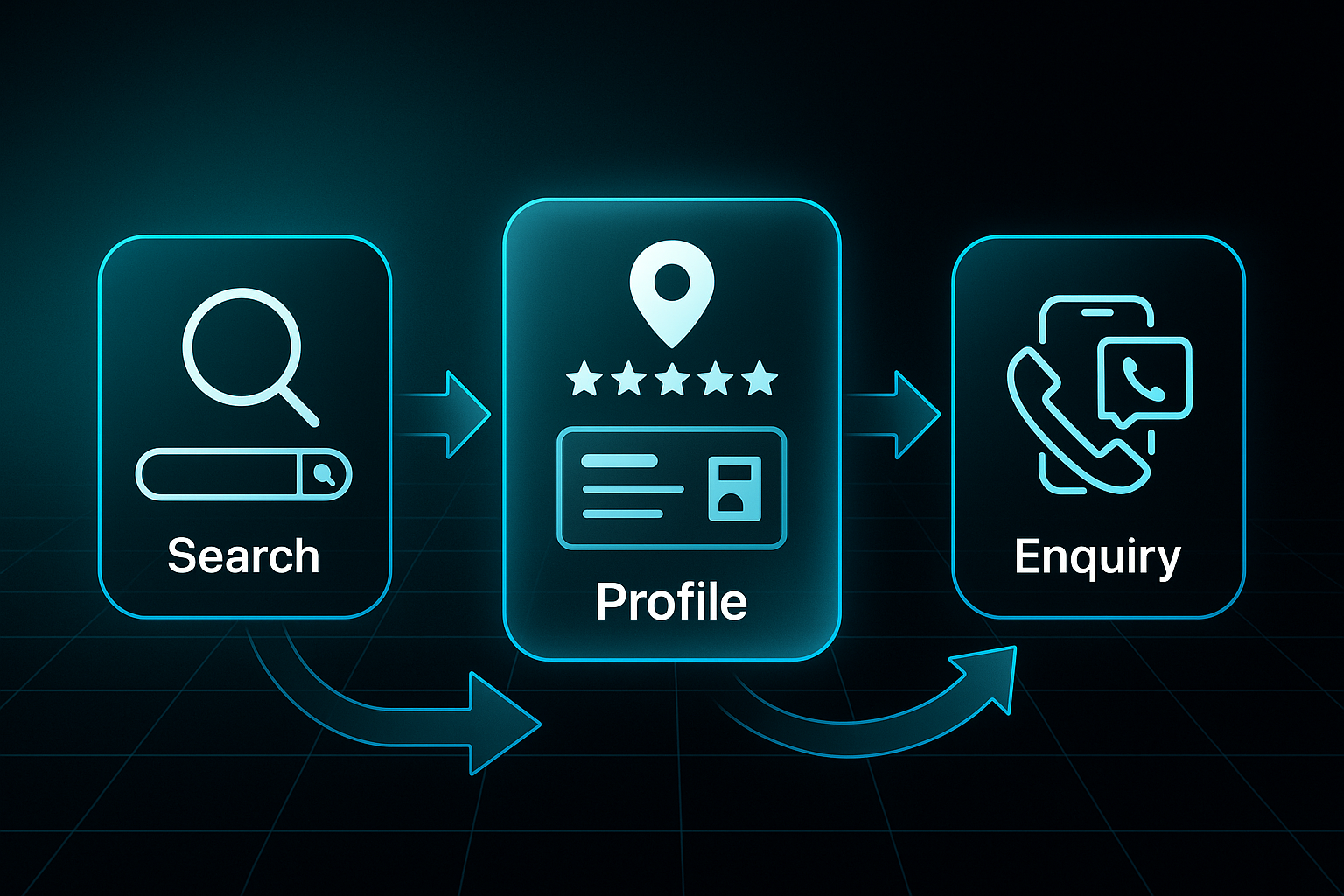
Trust is everything here. Clients want clear signals before they let anyone into their homes, especially for urgent callouts. Automated review platforms like BirdEye (from $300/month) and ReviewTrackers (from $49/month) help collect and display customer feedback, boosting online reputation and confidence.
A significant 84% of consumers trust online reviews as much as personal recommendations, highlighting the critical role of digital reputation in the home services industry.
Now, let’s talk paid leads. Google Local Services Ads typically run $20–$50+ per lead, while sites like HomeAdvisor charge $20–$80+ per enquiry. Being swift with responses and showing verified credentials and plenty of positive reviews really matters—in fact, it’s often the deciding factor.

How HVAC industry factors shape marketing approaches
Seasonality plays a massive role. Demand surges during extreme weather, so you need campaigns ready before the rush. The urgency of service calls means top-of-search ads and instant booking platforms gain an advantage—because nobody wants to wait when the boiler fails.
There’s tough local competition, so standing out through local SEO and proactive review management is vital. Regulatory compliance also shapes advertising—licensing information and environmental disclosures must be clear. Most customers aren’t technical, so sharing FAQ pages, DIY tips, and seasonal checklists can set your company apart from others.
Pain points and business goals for HVAC marketers
HVAC businesses face fierce local rivals, unpredictable lead flow, and budget pressure. How do you stay visible, build authority, and ensure reliable leads?
The solution is to optimise profiles, automate review requests, and plan campaigns ahead of peak periods. Paid advertising isn’t cheap—expect $40+ per click on Google Ads and $20–$80+ per lead from aggregators.
Smart moves include regularly updating your Google Business Profile, sending automated review requests, using affordable Facebook ads ($1–$3 CPM), and building referral programmes. To keep leads coming in and relationships strong, set unique contact points for each channel, track cost-per-lead and conversion rates, and adjust monthly for better results.
A successful HVAC referral program can be a powerful tool for generating new leads and retaining existing customers.
Understanding the HVAC Industry Landscape and Its Marketing Challenges
Audit Your Local Competition
Let’s start by mapping the competition. Use Google Maps, BrightLocal Local Search Grid (from $39/month), or Whitespark Local Rank Tracker ($20–$30/month) to spot your top 10–20 local competitors. Log their star ratings, review numbers, booking features, and certifications in a spreadsheet.
Set aside 2–4 hours for this research—any team member can help. If your local market’s quiet, widen your area.
This process helps pinpoint gaps—maybe one company has loads of reviews but no online booking. Those gaps are your chance to stand out.

Plan for Service Peaks
It pays to understand your cycles. Review the past 12–24 months of service call logs or CRM data for demand peaks, then compare with local weather trends (Weather.com or NOAA).
Launch peak campaigns 3–4 weeks ahead of your busy season. Assign 60–70% of your ad budget to 8–10 high-demand weeks; expect Google Local Services Ads at $40–$80 per lead. Try “AC Rush” or “Furnace Blitz” push campaigns with SMS reminders. To smooth out the slow times, use referral offers and discounted tune-ups—aiming to keep off-peak dips under 30%.
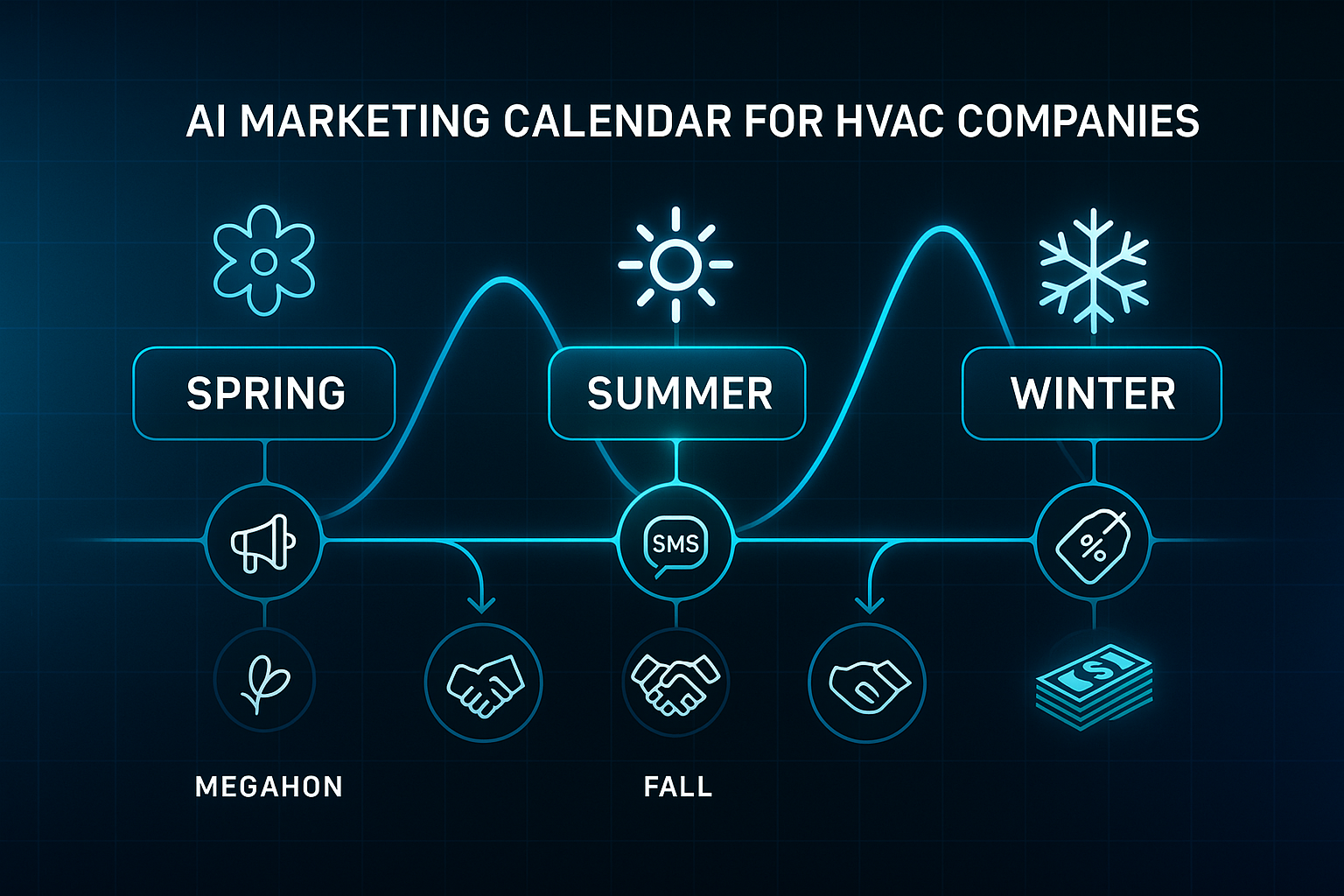
Stay Compliant and Credible
Quarterly audits keep you on track. Use the ENERGY STAR Partner Portal (free) and ACCA checklists (membership: $39–$399/year). This takes about 2–5 hours per quarter. Remove any unverified efficiency claims and update technician credentials as needed.
If you spot an issue, pause ads and sort it quickly.
Differentiate Through Tech
Standing out means embracing the right tools. Choose an online booking system (Housecall Pro from $49/month or Jobber from $19/month), automate review requests (BirdEye from $300/month or ReviewTrackers from $49/month), and clearly display technician details.
Have staff try booking through competitors’ sites—you’ll often discover missed tricks. Plan 2–6 hours for implementation. These upgrades can mean 15–30% more inbound calls and up to a 25% boost in reviews within six months.
After implementing an online booking system, one HVAC business experienced a 30% reduction in inbound calls for scheduling, freeing up dispatchers to handle more complex customer inquiries.
Set KPIs and Review Progress
Decide on your KPIs: cost per lead ($50–$80), revenue per season, under-24-hour review responses, regular audits. Check your CRM and Google Business Insights every month, benchmarking against last year.
Miss targets for two months? Adjust budgets, refresh campaigns, or explore channels like Nextdoor. Allocate 2–3 hours monthly for review, so you’re always ready to adapt if the market shifts.
Ready for the next step? This is where strategy becomes real growth.
How to Build an HVAC Marketing Plan: Key Steps and Essentials
Conducting a Comprehensive HVAC Marketing Audit: Step-by-Step Actions, Tools, and Validation
Let’s start with the groundwork: a robust marketing audit. This isn’t just a box-ticking exercise—it’s the springboard for growth.
Begin with your website. Run Screaming Frog SEO Spider (up to 500 URLs) to catch hidden SEO problems. Use Google PageSpeed Insights to hit that magic target of under three seconds for load times—because who waits for a laggy page? Check mobile usability and calls-to-action with Hotjar, so visitors don’t get lost or frustrated.
Are your Name, Address, and Phone (NAP) details identical everywhere? Inconsistency dims trust.
Tidy up your Business Profile Manager (formerly GMB)—aim for 100% completeness, plus at least ten recent reviews. Wipe out duplicates and stale entries. For a full directory sweep, Whitespark and Moz Local help you claim or update places like Yelp, Angi, HomeAdvisor, BBB, and Thumbtack. Set Google Alerts to catch new reviews and mentions, so nothing slips by.
Now, take a hard look at your socials. Your branding should match on each one, engagement rates need to be above 1%, and you’ll need to keep up with replies. Tools like Hootsuite or Sprout Social simplify monitoring.
But don’t neglect your offline assets. Vehicle wraps, cards, flyers—all should mirror current branding and accurate NAP. Test QR codes and tracking numbers using CallRail, making sure every offline touchpoint connects back to your marketing data.
For validation, check your web conversions in Google Analytics, and fix any broken web or directory items. Respond quickly to reviews, keep your social profiles active and consistent, and double-check that all printed assets track properly. Avoid pitfalls—like outdated contact info or ignored reviews—by keeping a checklist and using platform notifications. Schedule audits every quarter, so nothing goes unnoticed.
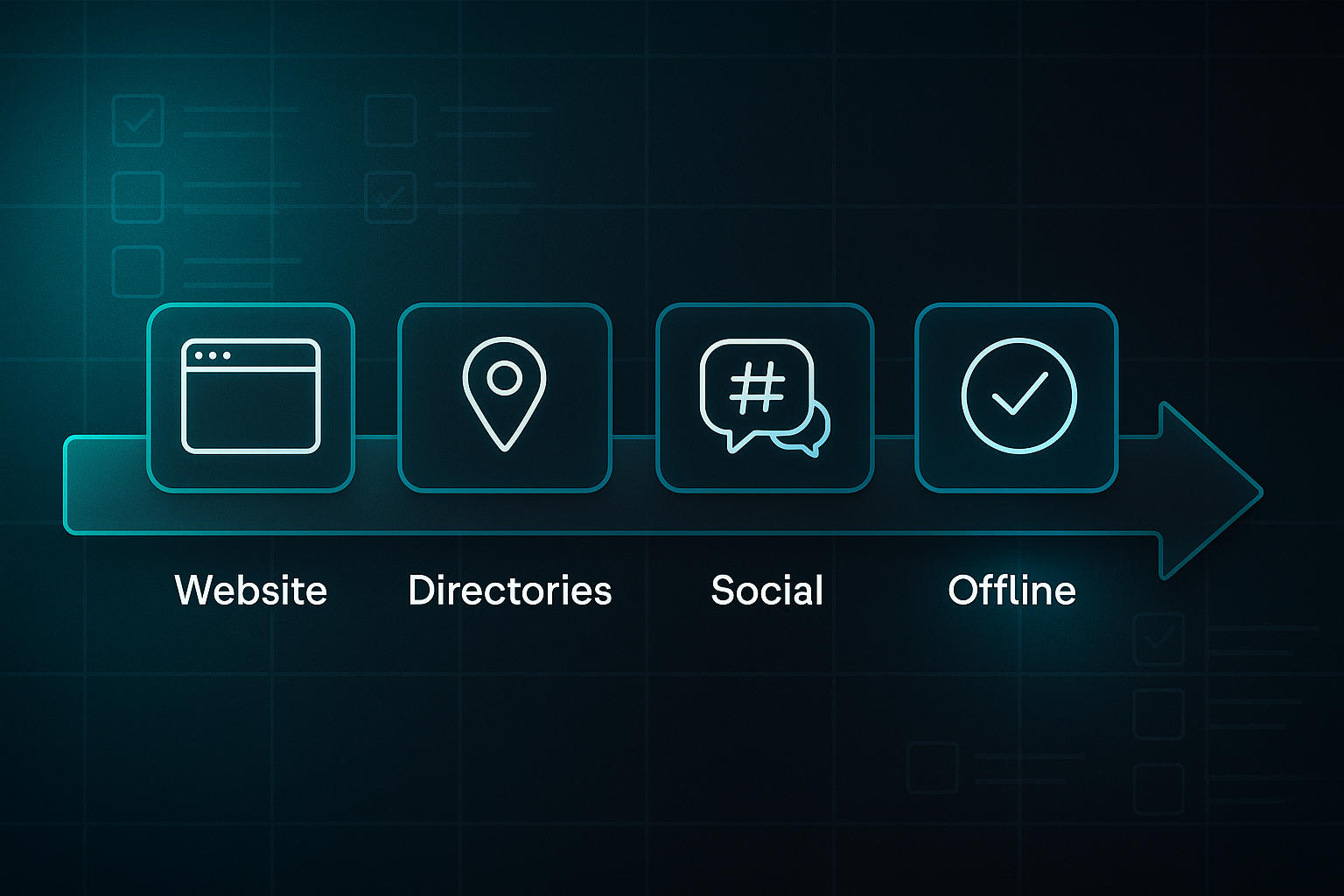
Defining Core Goals and Target Audience Segmentation
Now, what are you actually hoping to achieve? Segment your customer base with CRM tools such as ServiceTitan or Housecall Pro—breakdown by region, equipment age, visit frequency, or spend.
Set tangible goals: try 50 new Google Local Service Ads leads monthly, a 30% increase in repeat bookings, or 20% more web traffic before summer. Develop personas—emergency callouts vs. routine maintenance—and shape campaigns for each.
Watch results for each group. If numbers slide, tweak your messaging, channels, or timing. For multiple locations, launch localised campaigns and check feedback to make sure you’re not making broad assumptions.
Channel Prioritisation and Budgeting
Budgeting is next. For businesses under $1M in turnover, allocate 7–10% of revenue to marketing; larger outfits can tighten to 3–8%. Most HVAC firms should prioritise Google and Facebook Ads, local SEO with Ahrefs or Moz, plus Mailchimp for email.
If the budget is tight, focus on organic SEO, Google Business Profile, and referrals. Use CallRail and dashboards for tracking ROI, and don’t be afraid to shift spend quickly if a channel underperforms. Rotate priorities and update listings on a regular schedule.
Planning for Seasonality and Adaptability
Want to stay ahead during peak times? Use management tools such as Housecall Pro, ServiceTitan, Trello, or Asana to coordinate campaigns.
Prepare a quarterly calendar—think ahead with summer AC promotions, winter heating pushes, and off-peak maintenance specials. Review analytics each month; if engagement or weather trends shift, adjust your offers quickly. For multi-location firms, regionalise your campaigns and refine timelines so every area feels relevant. That way, you’re always ready to seize opportunities and dodge seasonal lulls.
Local SEO and Digital Presence: Cornerstones of HVAC Marketing Success
Optimise Your Google My Business Profile and Local Directories
Start by locking down your Google My Business profile—fill in every last detail. Don’t just add your business name and phone number; update categories, service areas, and opening hours—including holiday tweaks.
Add high-quality, geo-tagged photos of your vans, team, and jobs. This visual honesty builds trust and tells Google you’re nearby.
Consistency matters—list your company on Yelp, Angi, HomeAdvisor, BBB, and local chamber sites. Even tiny differences (“St.” versus “Street”) can hurt rankings. Tools like Moz Local or BrightLocal help check and fix these issues.
Want a reputation lift? Automate review requests with BirdEye, Podium, or ReviewTrackers. Satisfied customers often just need a nudge.
Letting listings slip out of sync drops your search results. The best fix? Schedule quarterly audits and update all entries.
Build and Optimise a Lead-Generating HVAC Website
Your website’s job: bring in new customers. It must be mobile-friendly, super-fast—under three seconds—and direct visitors to “Book Now” or “Call Today” from every page.
Confidence grows when you display real testimonials, review widgets, team photos, and industry badges near your CTAs. People want proof before booking.
Make dedicated landing pages for each main service and target area—like “Furnace Replacement in Kensington”—with Google Maps embedded, correct NAP details, and local content. Add schema markup (LocalBusiness, Service, Review) using TechnicalSEO.com’s Schema Generator to improve local search.
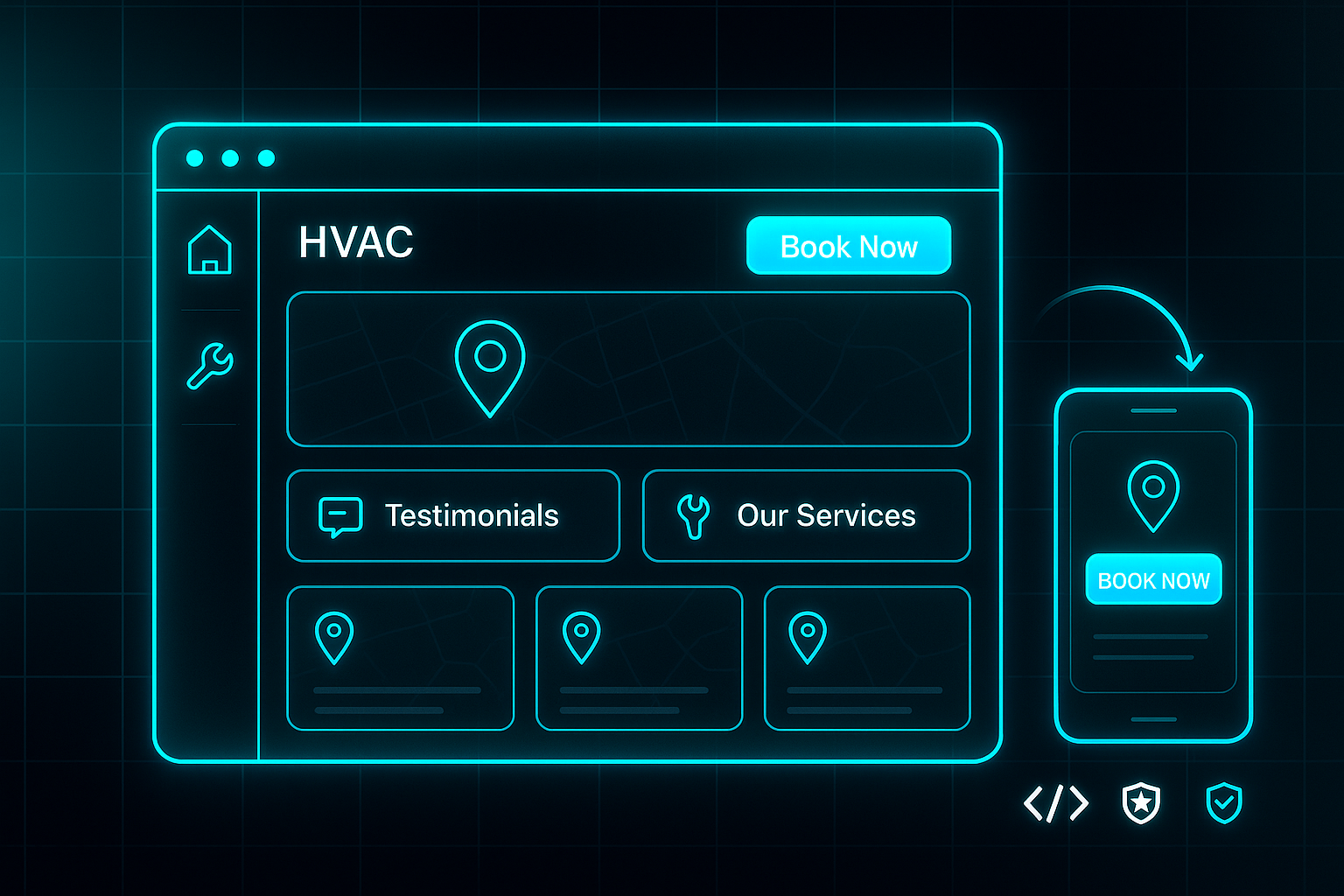
Monitor everything in Google Analytics. If bounce rates spike or mobile conversions lag, improve CTA placement and contact forms for smoother navigation.
Mobile visitors drop away fast when forms or buttons don’t work well. Tighten those up and you’ll see better conversion.
Attract and Convert with HVAC-Focused Content Marketing
Answer burning local questions in your blog—urgent or seasonal topics work best. Find what people are asking locally with Ahrefs, SEMrush, or Google Keyword Planner.
For every town or suburb you serve, publish unique blog posts or FAQs. Try “Preparing Your Air Conditioning for Summer in Reading.” Use downloadable checklists or voucher pop-ups to turn readers into enquiries.
If content creation keeps slipping, SEOSwarm can handle research, writing, optimisation, and publishing, freeing up your team while rankings grow.

AI-Powered
SEO Content Strategy
See the AI platform that's replacing entire content teams
(with better results).

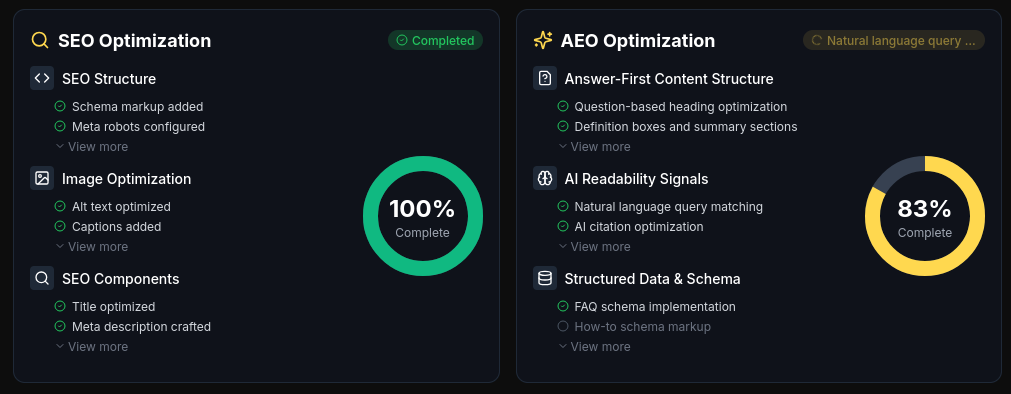
Struggling with local rankings? Add town/city phrases to your content and link back to essential service pages.
Proactive Review and Reputation Management
After every job, send polite review requests via SMS or email—always with a direct link to your Google review page. Reply promptly and professionally, and resolve complex issues offline.
Highlight top reviews on your site. If you cover more than one branch, dashboards like BirdEye or Podium make monitoring easier.
Low review volume? Ramp up automated requests and set a monthly goal, such as ten reviews. Take this seriously and your reputation will climb.
Traditional Marketing and Community Outreach for HVAC Companies
Building Local Trust With Community Engagement
For HVAC firms, community visibility is the backbone of trust—service calls often begin with familiar faces. Use your CRM to target relevant fêtes, school fairs, and club sponsorships where you’re likely to connect with real potential customers.
Budget £80–£2,400 per event and £3–£10 for each branded giveaway. Confirm your branding lines up, and announce involvement in local Facebook groups or Nextdoor to spark more interest.
When you’re at events, collect leads with QR codes, tablets, or prize draws offering discounts.
Get staff chatting to attendees and tracking each contact, aiming to follow up within 48 hours.
Struggling with engagement? Tweak your set-up or try hands-on workshops around seasonal needs—they often trump simple stands.
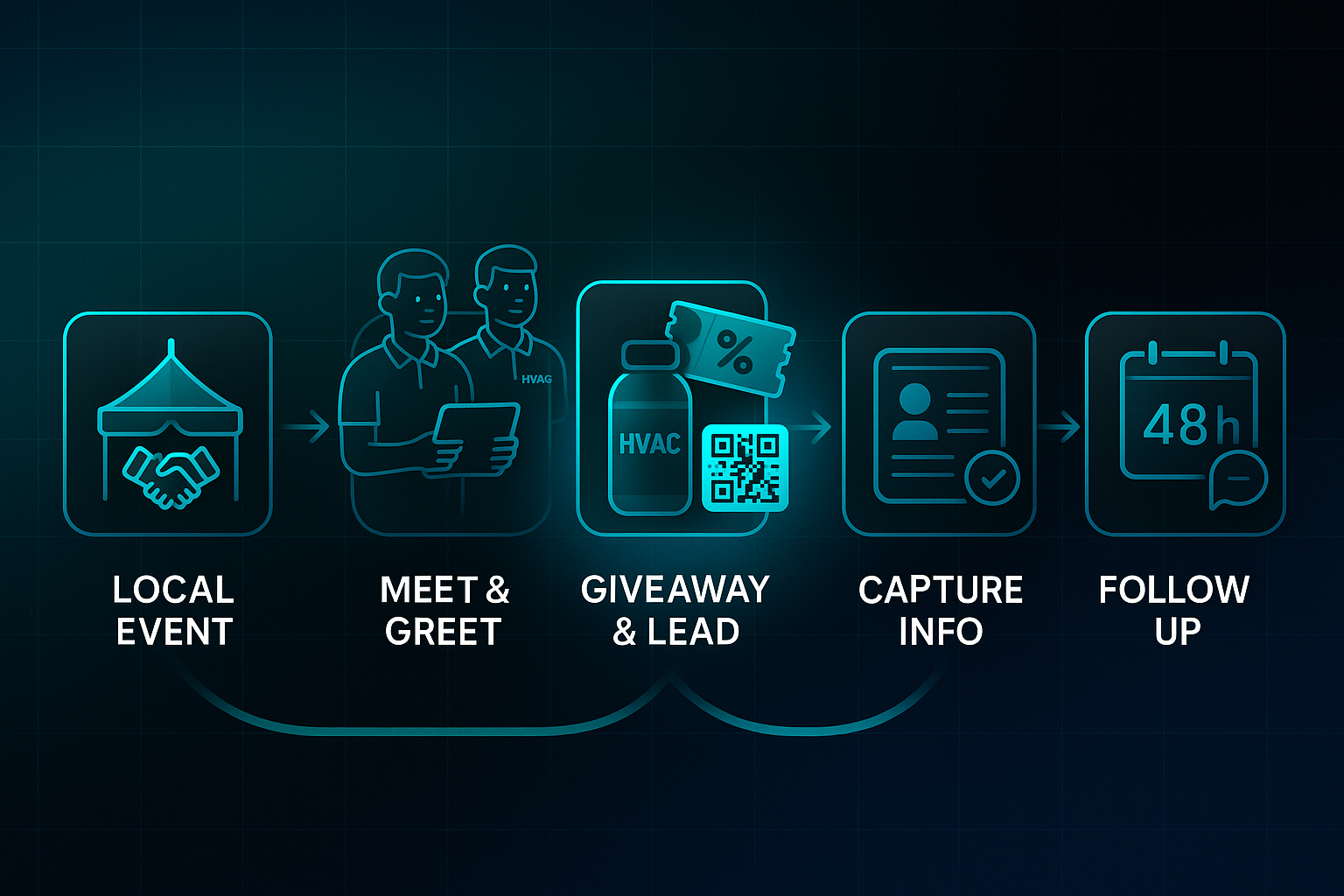
Effective Referral & Loyalty Programmes
Referral and loyalty schemes can drive 18–28% of new bookings. Platforms like Referral Rock (from $200/month), ServiceTitan, or physical referral cards tracked in your CRM all work well.
Reward both sides—£75–£100 for installs, £25–£40 for services, always paid promptly. Keep eligibility simple, and drop referral links into emails and handouts.
Monitor bookings in your CRM, shooting for at least 20% by referral within six months. Not enough momentum? Change up your incentives or use physical reminders if digital slows down.
Print and Offline Tactics That Win
Door drops, postcards, and vehicle wraps (£1,200–£3,000) are effective for homeowners over 40, generating 2–4% response rates. Always use unique codes for tracking in your CRM.
Distribute materials 2–4 weeks ahead of busy periods via Royal Mail or hand delivery. Rotate your target areas to keep results strong.
Channel Selection & Success Measurement
Budget under £1,500/month? Focus on referrals and print. From £4,000+, add event sponsorships. Pick channel types by local audience—print for older households, events for young families.
Set KPIs: 2.5% mail response, 10+ leads/event, 20% bookings from referrals. Use your CRM to pause any channel that drops below £4–£10 returned per £1 spent.
- Local event leads
Target 8–12 per event, and track the source. - Referral bookings
Aim for 20%+ within six months. - Print response
Expect 2–4%, validated by code. - ROI threshold
Seek £4–£10 return per £1 spent, per channel.
Paid Advertising Strategies: Digital and Offline Opportunities for HVAC
Step 1: Are You Ready for Paid Advertising?
Wondering if paid advertising is the right step? Start if you have a £500/month marketing budget, want 20+ extra leads monthly, and can reply to new enquiries within 15 minutes.
Your basics must be solid—mobile-friendly website, click-to-call, active call tracking (think CallRail), and a fully optimised Google Business Profile. Block out 2–4 hours a week for campaign setup and quick checks, handled by your staff or a capable agency.
Step 2: Running Digital Campaigns (Google, Facebook, Instagram)
Here’s where most leads begin.
Launch Google Ads and Local Services Ads with location-based campaigns—attach call tracking from day one. Set an initial budget of £500–£1,000/month and target priority keywords like “boiler repair”. Over the first two weeks, review every few days. Your target: £20–£50 per lead and a 2–5% conversion rate. Pause ads over the £50 CPL mark.
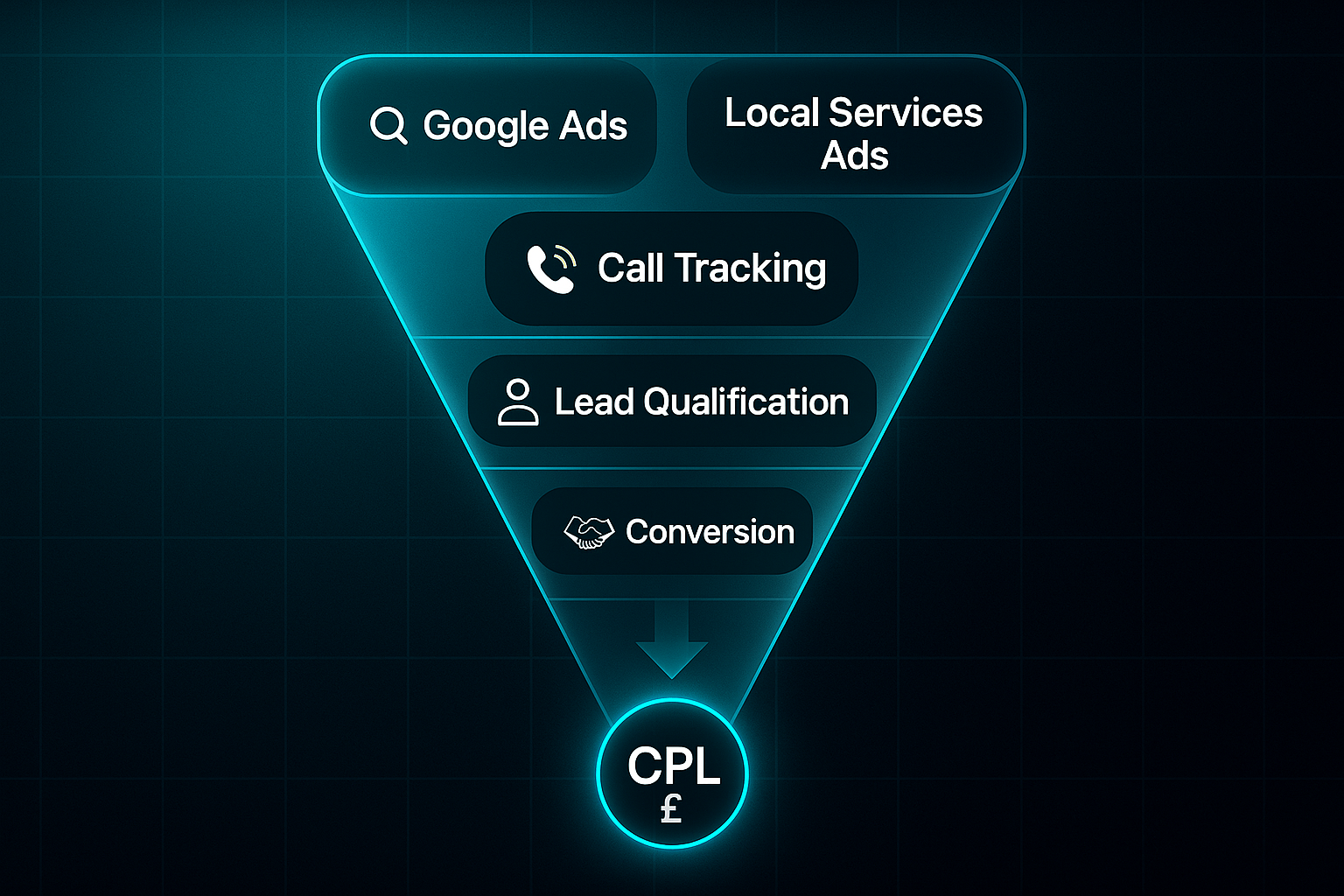
For Facebook/Instagram, focus on homeowners aged 30–65+ in your service areas. Test two types of ads: one for seasonal offers, another for urgent repairs. Lean on strong visuals and real customer quotes. Start with a £200–£500/month test. Adjust targeting or creative if click costs climb. Retarget your site visitors—they’re most likely to convert.
Step 3: Boost Leads With Marketplaces
Don’t neglect Checkatrade, Rated People, or TrustATrader for extra bookings.
Keep your listings current with real job photos and credentials and delegate lead follow-up—speed is key. Try each site for 7–14 days. Track cost per lead (£30–£100) and booking rate (aim for 5% minimum). If any source brings over 40% of paid leads, spread your investment to other channels for balance.
Step 4: Harness Print, Mail, and Sponsorships
Traditional routes still pull weight—especially in areas where digital isn’t king.
Send 500–2,000 targeted mailers via Royal Mail or local leaflet drops, tailoring your offers and tracking each campaign with unique numbers or QR codes. Prep takes 2–4 hours, expect 2–4% response and £50–£200 per lead. If you see response dip under 2%, pause before mailing again.
Step 5: Monitor, Optimise, and Avoid Pitfalls
Before any launch, check your call tracking and website mobile-friendliness.
Regularly add negative keywords, pause underperformers, and keep print batches small until proven. Every month, review which channels deliver the best results—shift your budget accordingly. Major pitfalls? Underfunding, weak messaging, skipping lead tracking. And never bet the farm on one tactic—the smart move is a mix, keeping your pipeline stable no matter the season.
Marketing automation and AI: Scaling HVAC marketing with modern tools
Lead nurturing and client retention with automation
Automating your lead nurturing and follow-ups can save hours every week. Housecall Pro, Jobber, and ServiceTitan make it easy to schedule reminders, review requests, and post-service emails—usually with 2–4 hours of setup and basic admin access.
To start, subscribe, update your customer list, and set permissions. Test a few bookings to check that messages send correctly by email and SMS. Each week, spend 30–60 minutes just fine-tuning or fixing any delivery glitches.
The main metrics? Aim for a 30–40% drop in no-shows in the first quarter and 25–30% of review requests to translate into actual reviews. Lead-to-booking rates should climb at least 10%. If automations misfire, update client contacts, contact support, or just ring the client. Micro teams may not need automation, and legacy CRMs might not integrate without fuss.
Streamlined admin and internal workflows
Platforms like FieldEdge, Service Fusion, or AI Automations (our solution) remove repetitive admin. Setup takes 1–2 days, with 1–2 people handling onboarding and weekly dashboard checks. Always validate by testing each workflow—like an onboarding message or escalation alert.
Manual backup is vital if something breaks—fall back on spreadsheets for urgent cases. Modern, API-enabled CRMs are ideal, and firms with just one or two office staff may see limited gains. Still, you want to be saving eight admin hours per week and see 40% fewer errors after 30 days.
AI-powered content and campaigns
Jasper.ai, SurferSEO, and SEOSwarm automate blog publishing and lead-gen campaigns. It’s a quick setup—insert a snippet or plugin, and you’re off. Budget 1–2 hours weekly for checks and approvals.

You should spot traffic or lead gains within 14–30 days. If posts stall, contact support or upload manually. For jobs needing highly specific local content, a human review may help.
These tools make sense for ongoing blog needs, with plans from £200/month.
Blending automation with the human touch
Keep messaging warm with personalisation tokens—use names, recent work, and refresh templates regularly. Route unusual or negative replies to staff within 10 minutes; train your team in one hour and schedule simple quarterly refreshers.
Review logs in your first two weeks, targeting a 95%+ message success rate. Should clients flag missed or confusing messages, pause the automation and follow up personally.
Automation works—just always make it easy for customers to reach real humans if they need support.
Standing out: Differentiation strategies for HVAC companies
Establishing Authority and Trust with Certifications, Transparency, and Social Proof
Let’s get straight to the point—visible credibility is your ticket to trust, especially when it comes to those first-time, high-value HVAC service calls. If you want homeowners to pick up the phone, you need to show them you’re an expert they can rely on.
That starts with putting your NATE (North American Technician Excellence) and EPA authorisations front and centre. Make sure these badges are on your website homepage, right above the fold—don’t hide them away. Stick them on service vans, technician uniforms, and every online profile you’ve got. The results speak for themselves: 42–47% of customers say visible accreditations nudge them towards booking.
Go further by vetting and documenting all technician training. Badges for background checks or safety courses make you look thorough and trustworthy. Entry-level certifications like NATE only cost £130–£200 per technician, and you’ll need to renew each year. Want to get technical? Advanced credentials such as ASHP or CFC cost £400+—worth weighing up as specialist staff can be hard to retain.
Social proof gives your authority a local shine. Update those before-and-after job galleries on your website and socials every month. Pair short technician bios with completed jobs, and collect customer stories (photos and permission essential). If you’re active in the community—sponsoring sports teams, offering complimentary checkups for nonprofits, or partnering with trusted organisations—you’ll soon notice more direct enquiries. The evidence? Firms promoting local initiatives and job galleries saw 14–22% more enquiries in just six months.
But what if something goes wrong publicly? Be ready with fast-response templates for negative PR—think 24-hour reply scripts that direct people to a dedicated contact. Reputation platforms like BirdEye (from £220/month) and ReviewTrackers (£49/month) keep those reviews positive and managed. Escalating major incidents to a specialist agency typically costs £150–£350.
And here’s a savvy move—wrap every offer and channel in branded guarantees: lifetime service promises, speedy call responses (under 30 minutes), the lot. If a competitor copies your idea, act quickly. Survey your clients, launch new loyalty perks, and develop ready-to-use adjustment scripts for your team. That way, you stay one step ahead and your standout features never lose their shine.
Your Competitors Are Using AI. Are You?
We help companies transition into the new age of marketing.

Low-Budget HVAC Marketing: Maximum Impact Tactics
Laying the Foundation
When money’s tight, you start with the basics. Make sure your Google Business Profile is fully up to date and every directory entry matches—down to the letter. Even tiny mismatches can hurt your local rankings.
Your website must do the job. Place your phone number boldly at the top, make CTAs easy to find, and showcase testimonials up front. If you cover a spread-out area, create a single “service zone” landing page with clear calls to action.
No-one on your team has to be a tech expert. Tools like Google Business Profile and BirdEye guide you with simple steps or templates, so even beginners can manage.
Content and Community on a Budget
Not a writer? No worries. Start a simple blog answering questions like “Boiler Maintenance Tips.” Use Google Keyword Planner to find what locals are searching for.
Building local partnerships can be done for free. Swap guest posts with a local electrician, or sponsor a school event to get your name into their newsletter—small moves, big reach.
Track and Optimise Consistently
Monitor what’s working via call-tracking numbers or a simple Excel sheet. Check these monthly: is your best lead source web, word-of-mouth, or events?
If something lags, tweak the offer or switch tactics. Flexibility is everything here.
Common Hurdles and How to Fix Them
You’ll face a few bumps along the way. Don’t panic—here are swift solutions:
- Low Reviews
Target two review requests weekly, automated by SMS/email. - Silent Website
Test contact forms on mobile monthly—fix any hiccups. - Skills Gaps
Use free YouTube tutorials and appoint your most tech-savvy staffer as guide.
Stick to these basics and iterate, and you’ll outshine better-funded rivals—just by being consistent, visible, and a little creative.
Measuring Success and Optimising Your HVAC Marketing Strategy
HVAC Marketing Metrics to Track in 2024
Let’s talk numbers—because getting results means measuring what matters. For HVAC firms, track the metrics that shape ROI and show which marketing levers really work.
Find out exactly where leads come from using systems like CallRail or ServiceTitan. Keep a close eye on your conversion rate; hitting 10%+ is worth celebrating, considering industry averages hover around 3%.
Keep tabs on customer acquisition cost (CAC)—the total spend per new customer. Work to lower this over time. SEO matters too: record organic lead volume, check keyword rankings, and watch website engagement through bounce rate and completed forms.
Running paid ads? Focus on click-through rates, cost-per-click, and conversion rates. Use A/B tests to keep campaigns sharp. Wrap up your tracking with regular reputation checks—numbers of reviews and star ratings after each campaign.
Set Up Measurement, Attribution and Reporting
Assign unique call-tracking numbers for each campaign using CallRail or ServiceTitan. Tag online ads with UTM codes and confirm the source in Google Analytics.
Log every lead’s origin in your CRM, and report by channel, campaign, and location for precise insights. Spend 2–8 hours for your initial setup, then train your team to review these figures each month.
Review, Troubleshoot and Optimise
Hold monthly sessions to review the stats. If conversions slip or leads drop, double-check tracking codes, CRM records, and website speed. Rising acquisition costs? Shift budget to stronger channels.
Refreshing review requests and updating templates keeps reviews flowing. Always back up CRM data before switching platforms, and have two admins to maintain system security.
Analytics Into Action
Let data guide you—reallocate spend, tweak content, and refine follow-ups every month. Use unique codes for offline channels to connect the dots. This steady workflow keeps your HVAC strategy resilient, targeted, and set up for strong returns.
Seasonal and Emergency Marketing Tactics for HVAC Companies
Pre-Season and Event-Driven Campaigns: Smart Preparation and Launch
Getting ready for peak season doesn’t just happen overnight. Start 3–6 weeks before things get busy. Roll out targeted offers with email, SMS, geo-targeted Facebook or Google Ads, and some well-placed direct mail. It helps to sync promotions with neighbourhood events and tie campaigns to the local calendar.
The data backs this up. Pre-season campaigns often drive a 20–35% jump in early bookings and around 19% more up-sells on tracked offers. Want real results? Sponsor nearby home shows or community fairs just as demand picks up. Capture leads with QR codes or tablets, then follow up quickly—this usually produces an 8–18% spike in post-event enquiries.
Here’s the twist. As weather shifts, launch event-triggered ads with real-time message updates—during high-demand periods, urgent ad variants boost click-through and bookings by over 29%. That means your team needs the basics sorted: fresh CRM records, briefed staff, compliance-checked offers, and mobile-first landing pages. Keep all campaign deadlines on a shared calendar.
Check campaign performance daily or weekly. For digital, aim for >3% response; for direct mail, >1.5%. If things stall, tweak the creative or offer fast. Use multi-channel conversion tracking for full clarity.
Avoid common mistakes—like launching too late, missing landing page updates, or having unprepared staff—by prepping assets early and conducting quick FAQ briefings. Compliance reviews are a must before launch.
Messaging and Outreach for Emergency Service Demand: Rapid Response in Action
When demand suddenly explodes, be ready with 24/7 Google or Paid Search ads and urgent “Book Emergency Service Now” calls-to-action. Add SMS and live chat for instant replies and chase any abandoned web leads.
Here’s where it gets clever. Plug weather APIs or event feeds into your CRM or ad platform for immediate launches and timed messaging. This approach, plus retargeting and same-day response offers, means up to 33% conversion gains during peak spikes.
Keep your on-call roster updated, craft backup ad copy for emergencies, and test your booking forms so zero leads slip away.
How do you steer the ship?
- IF a weather alert hits
THEN ramp up ad spend. - IF responses dip
THEN refresh messaging or try a different channel. - IF staff get swamped
THEN redirect calls or pause smaller campaigns.
Review logs and feedback daily, and use a simple checklist for compliance, mobile experience, and ready-to-launch assets. Stay agile—it’s how you avoid missteps and keep new jobs rolling in.
My Final Thoughts on Marketing for HVAC Companies
Most HVAC companies lose leads not because of poor service, but because their marketing basics slip through the cracks. I’ve seen businesses double their bookings just by tightening up Google Business Profiles, automating review requests, and prepping campaigns ahead of peak seasons.
Here’s my advice: Audit your online presence quarterly, track every lead source, and set clear KPIs for cost-per-lead and conversion rates. Use automation for follow-ups and reviews, but always keep a human touch for urgent or complex enquiries. If your budget is tight, focus on local SEO, referral programs, and community events—they deliver strong returns without draining resources.
Marketing for HVAC isn’t about chasing every trend—it’s about consistency, smart measurement, and adapting quickly when the market shifts. The companies that thrive are those that treat marketing as a living system, not a checklist. Stay visible, stay responsive, and your business will be the one homeowners call first.
- Wil







